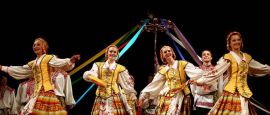Belarus Weather, climate and geography
Weather & climate
Belarus enjoys a seasonal, continental climate with long, cold winters and warm, temperate summers. It experiences huge temperature fluctuations throughout the year, with the extremes of each season ensuring that Belarus isn't a typical year-round destination for tourists.
The best time to visit is during the warmer months from May to September when the days are longest and the weather is mild. In July and August temperatures can reach highs of 25°C (77°F) although the average is 18°C (64°F). Summer is the perfect time to enjoy the Belarusian countryside and forage in the forests for wild berries.
Winter starts in December and finishes in February, with temperatures hitting lows of -4°C (24.8°F) on average. In Eastern parts of the country the snow lasts around a month longer, so winter often lasting four months rather than the usual three.
Once spring arrives and the 'thaw' begins, temperatures increase rapidly, and while it's uncommon, April can creep into the mid 20's°C (70's°F), so travelling in spring is also a viable option for tourists looking to save some money and enjoy Belarus at an off-peak time of year.
Rain is also common in Belarus, with between 5 and 7 days of precipitation on average per month – the volume of this can fluctuate, with Belarus receiving 600-700mm of rainfall annually.
Minsk, the capital, is situated in the heart of Belarus and experiences both the heat of summer and the cold of winter. July and August are peak season for Minsk in terms of weather, with average temperatures of 26°C (79°F) throughout the days in August and lows of 15°C (60°F) during August nights. The humidity level in summer is much higher in Minsk, so the chance of precipitation is also increased.
Brest is centrally located and experiences similar weather to Minsk. With the August average reaching a balmy 27°C (81°F) in the day and 15°C (60°F) at night, the climate is comparable to the capital if not slightly warmer. Brest is more humid than its Eastern counterpart however, and rain is more likely. The peak time to visit Brest is in the heart of summer during July, so bear this in mind when arranging travel.
In the winter you'll need to account for cold temperatures, so wearing medium to heavyweight clothing is advisable. Jeans, knits and heavy coats, as well as good boots are a minimum requirement. In the summer, depending on whereabouts you’re visiting, thinner cottons, linens, shorts and t-shirts will be fine. Waterproofs are advisable throughout the year due to the prevalence of rain.
Do you have any Feedback about this page?
© Columbus Travel Media Ltd. All rights reserved. No part of this site may be reproduced without our written permission, click here for information on Columbus Content Solutions.
¿Tiene comentarios sobre esta página?
© Columbus Travel Media Ltd. All rights reserved. Ninguno de los contenidos de esta Web debe ser reproducido sin nuestra autorización expresa y escrita. Para más información sobre como obtener permiso para la utilización del contenido clica aquí. No part of this site may be reproduced without our written permission, click here for information on Columbus Content Solutions .
Avez-vous des commentairessur cette page?
© Columbus Travel Media Ltd. All rights reserved. Le contenu de ce site ne peut être reproduit sans autorisation écrite. Cliquez ici pour plus d'information sur notre 'des solutions de contenu’. No part of this site may be reproduced without our written permission, click here for information on Columbus Content Solutions.
Haben Sie Feedback zu dieser Seite?
© Columbus Travel Media Ltd. All rights reserved. Alle Inhalte dieser Seite sind urheberrechtlich geschützt und dürfen nur mit schriftlicher Genehmigung des Verlags genutzt werden. Weitere Informationen finden Sie in unseren Lizenzbestimmungen. No part of this site may be reproduced without our written permission, click here for information on Columbus Content Solutions .





 You know where
You know where